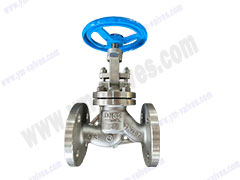-
【Valve Knowledge】Classification of Check Valves
-
1. Classification by Structural Form
(1) Swing Check Valve
Working Principle: The valve disc rotates around a fixed axis. When the fluid flows in the forward direction, the valve disc is pushed open. When the fluid flows in the reverse direction, the valve disc falls back and seals due to its own weight and fluid pressure.
Sub-types:
Single-flap type: Suitable for small and medium-sized pipes. The structure is simple but the water hammer effect is more obvious.
Double-flap type/multi-flap type: Commonly used for large-diameter pipes. The impact force is dispersed through multiple valve discs to reduce the risk of water hammer.
Features: Small flow resistance, flexible opening and closing, suitable for large flow and low flow rate conditions, but the sealing performance is weaker than the lift type.
Application: Water supply and drainage, municipal engineering, petrochemical industry, etc.
(2) Lift Check Valve
Working Principle: The valve disc slides along the vertical center line. The fluid pressure pushes the valve disc open. When the fluid flows in the reverse direction, the valve disc falls and closes.
Sub-types:
Straight-through type: The inlet and outlet channels are vertical and need to be installed horizontally. The sealing performance is excellent.
Vertical: The inlet and outlet channels are in the same direction, can be installed vertically, and have low flow resistance.
Features: High pressure resistance, strong sealing, but large flow resistance, and high requirements for fluid cleanliness.
Application: High-pressure small-diameter pipelines, steam systems, petrochemicals, etc.
(3) Butterfly check valve
Working principle: The disc-shaped valve disc rotates around the central axis, with fast opening and closing speed and compact structure.
Features: Small size and light weight, suitable for pipelines with limited space, but the sealing performance is average, and is often used in medium and low pressure occasions.
Application: Water supply and drainage, sewage treatment, shipbuilding, etc.
(4) Axial flow check valve
Working principle: The axial flow of the fluid pushes the valve disc, and when closed, the valve disc falls back smoothly along the axis, with extremely low flow resistance (≤0.4).
Features: Significant energy-saving effect, smooth opening and closing without noise, suitable for long-distance pipelines and systems sensitive to pressure loss.
Application: Oil and gas transportation, pump outlet pipelines, etc.
(5) Ball check valve
Working principle: The spherical valve core is separated from the valve seat under the action of the fluid to open, and the ball returns to its original position and seals when the flow is reversed.
Features: Full-bore design, low flow resistance, and can adapt to medium containing particles or high viscosity.
Applications: Sewage treatment, chemical slurry transportation, etc.
(6) Shuttle anti-pulsation check valve
Working principle: Designed for pulsating flow conditions, the valve core moves stably through springs and damping structures to reduce wear caused by frequent opening and closing.
Features: High pressure resistance, pulse shock resistance, suitable for reciprocating compressors or pump outlets.
Applications: Petrochemical, high-pressure gas transportation, etc.
2. Classification by function and application scenario
(1) Silent check valve
Design features: Spring-assisted valve disc quickly resets to reduce impact noise when closing.
Sub-types: Various structural forms such as lift type, swing type, ball type, etc.
Applications: Civil building water supply and drainage, HVAC, power plants, etc., which are sensitive to noise.
(2) Bottom valve
Function: Installed at the bottom of the pump suction pipe to prevent liquid backflow and maintain the system water filling state.
Structure: Piston type or swing type, often with a filter to prevent impurities from clogging.
Application: Well pump system, agricultural irrigation, fire protection, etc.
(3) Duckbill valve (rubber sewage check valve)
Structure: All rubber material, no moving parts, relying on elastic deformation to open and close.
Features: Anti-clogging, maintenance-free, low opening pressure (>0.01 meter head), suitable for sewage containing solid particles.
Application: Municipal flood drainage, sewage treatment, coastal engineering, etc.
(4) Intelligent zero flow check valve
Technical features: Integrated sensor and control module, real-time monitoring of flow rate and optimization of opening and closing characteristics, eliminating water hammer effect.
Application: Intelligent water services, industrial automation systems, etc.
3. Classification by material
(1) Metal material
Cast iron: low cost, suitable for normal temperature and low pressure water systems.
Carbon steel/forged steel: resistant to high pressure and high temperature, commonly used in the petrochemical and power industries.
Stainless steel (such as 304/316): corrosion-resistant, suitable for high-demand scenarios such as chemical, food and medicine.
Brass: rust-resistant, mostly used in HVAC pipes and small-diameter threaded connection systems.
(2) Non-metallic materials
Plastics (such as PP, PVC): lightweight, chemical-resistant, suitable for low-pressure clean water or corrosive media.
Rubber: good flexibility, often used in duckbill valves or occasions requiring vibration and noise reduction.
4. Classification by connection method
(1) Threaded connection: suitable for small-diameter pipes and easy to install.
(2) Flange connection: strong versatility, can adapt to a variety of pressure levels and diameters.
(3) Welding connection: good sealing, suitable for high-temperature and high-pressure or leakage-sensitive systems.
(4) Wafer connection: compact structure, space-saving, often used in butterfly or double-flap check valves.
5. Classification by special working conditions
(1) High-temperature and high-pressure check valve: Made of high-temperature resistant materials (such as Stellite alloy), suitable for thermal power plants, metallurgy, etc.
(2) Low-temperature check valve: Designed for low-temperature media below -196℃ (such as LNG, liquid oxygen) to prevent freezing damage.
(3) Exhaust check valve: Controlled by solenoid valve and cylinder, it prevents abnormal pressure in the turbine and is used in the exhaust system of power plants.




.jpg)
.jpg)
.jpg)